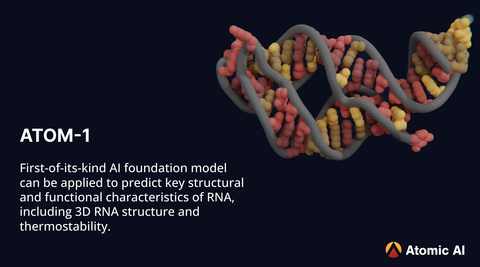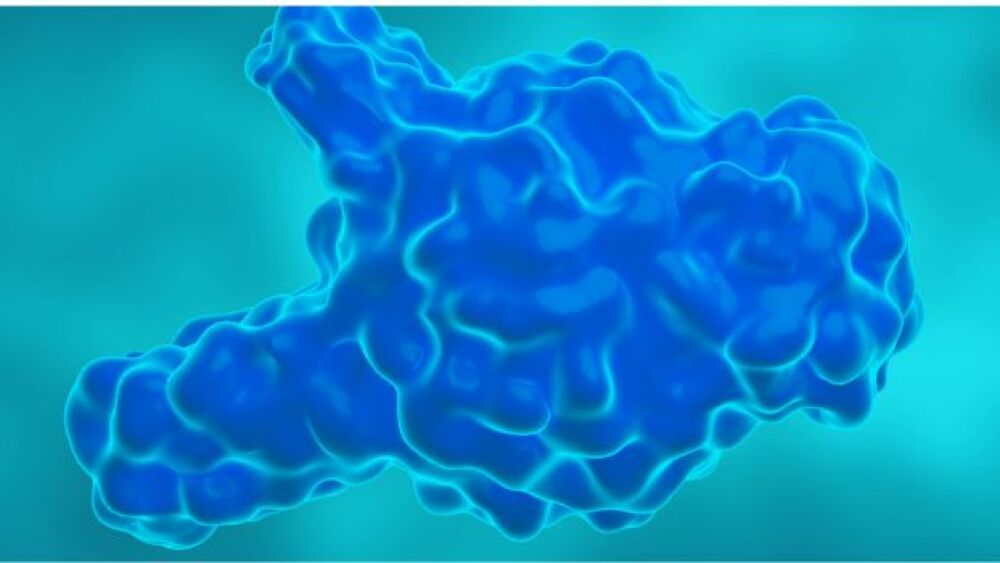Atomic AI, a biotechnology company fusing cutting-edge machine learning with state-of-the-art structural biology to unlock RNA drug discovery, announced that the Company has created the first large language model (LLM) leveraging chemical mapping data.
Atomic AI’s ATOM-1 large language model (LLM) demonstrates state-of-the-art accuracy for predicting RNA structure and function
Technology can be exploited to evaluate and optimize key features critical in developing RNA-based and RNA-targeting drug modalities
ATOM-1 uniquely enabled by billion-scale chemical mapping datasets collected in-house by Atomic AI
SOUTH SAN FRANCISCO, Calif.--(BUSINESS WIRE)-- Atomic AI, a biotechnology company fusing cutting-edge machine learning with state-of-the-art structural biology to unlock RNA drug discovery, announced that the Company has created the first large language model (LLM) leveraging chemical mapping data. In a preprint paper published on bioRxiv, Atomic AI describes its proprietary ATOM-1™ platform component, a foundation model that can accurately predict the structure and function of RNA and help dramatically improve development of RNA therapeutics.
This press release features multimedia. View the full release here: https://www.businesswire.com/news/home/20231215527488/en/

(Graphic: Business Wire)
The recent advances in messenger RNA (mRNA)-based COVID-19 vaccines have highlighted the potential of RNA-based and RNA-targeting therapies for the treatment of a broad range of conditions, from infectious diseases and cancer to neurodegenerative diseases. However, there are issues with current methods for designing and discovering RNA therapeutics stemming from the lack of data available to predict the structure and function of RNA. To date, there have been little high-quality RNA data available to the life sciences community because available approaches, such as animal models for collecting in vivo information or cryo‐electron microscopy (cryo‐EM) for determining 3D RNA structure, are difficult to use and time-consuming for data collection. Due to this deficiency of “ground-truth” data, it has been challenging to optimize key RNA therapeutic characteristics, including stability, toxicity, and translational efficiency.
“ATOM-1 enables the prediction of structural and functional aspects of RNA as well as key characteristics of RNA modalities, including small molecules, mRNA vaccines, siRNAs, and circular RNA, to aid in the efficient design of therapies,” said Manjunath "Manju" Ramarao, Ph.D., Chief Scientific Officer of Atomic AI. “Our goal is to create a streamlined drug discovery process to advance our own pipeline and work with partners to help validate their RNA targets and tools, to ultimately get needed therapeutics to patients quickly and more efficiently.”
In the paper, “ATOM-1: A Foundation Model for RNA Structure and Function Built on Chemical Mapping Data”, researchers from Atomic AI created a novel platform component leveraging large-scale, chemical mapping data collected in-house using custom wet-lab assays. The scientists collected data on millions of RNA sequences, with over a billion nucleotide-level measurements. Trained on this data, ATOM-1 has gained a rich understanding of RNA, and can then be leveraged to optimize the properties of different RNA modalities.
“By building large datasets based on RNA nucleotide modifications and next-generation sequencing, the team at Atomic AI has created a first-of-its-kind RNA foundation model,” said Stephan Eismann, Ph.D., Founding Scientist and Machine Learning Lead at Atomic AI. “We are excited about how broadly applicable our model is to other aspects of RNA research, and its potential for optimizing various properties of RNA-based medicines, such as the stability and translation efficiency of mRNA vaccines or the activity and toxicity of siRNAs.”
Compared to previously published methods, ATOM-1 is able to more accurately predict RNA secondary and tertiary structure. Remarkably, in a retrospective analysis comparing ATOM-1 to other computational tools for vaccine design, ATOM-1 outperformed all 1,600 other methods for predicting in-solution mRNA stability. Based on these results, the new foundation model can be tuned with a limited amount of data to predict different properties of RNA, not only to determine the structure of RNAs but also to predict other key features of RNA therapies.
“Over the last two and a half years, we’ve been purposefully designing and collecting data to train our foundation model,” said Raphael Townshend, Ph.D., Founder and CEO of Atomic AI. “Through machine learning and generative AI, we now have a unique opportunity with ATOM-1 to predict RNA structure and function with high precision by tuning it with just a small amount of initial data points.”
About Atomic AI
Atomic AI is an emerging biotechnology company exploiting the cutting-edge fusion of artificial intelligence and structural biology to unlock RNA drug discovery. Based on research prominently featured in Science, Atomic AI’s proprietary R&D platform leverages state-of-the-art deep learning foundation models integrated into a virtuous cycle with purpose-designed, in-house wet-lab assays, to discover and design RNA-targeted and RNA-based medicines. Backed by an interdisciplinary team of machine learning researchers, medicinal chemists, engineers, and experimental biologists, as well as strategic scientific advisers and world-class investors, Atomic AI is leading the way in AI-augmented structural biology and transforming the design of RNA medicines to treat undruggable diseases. To learn more, visit atomic.ai and engage with us on LinkedIn and X (formerly Twitter).
View source version on businesswire.com: https://www.businesswire.com/news/home/20231215527488/en/
Source: Atomic AI







